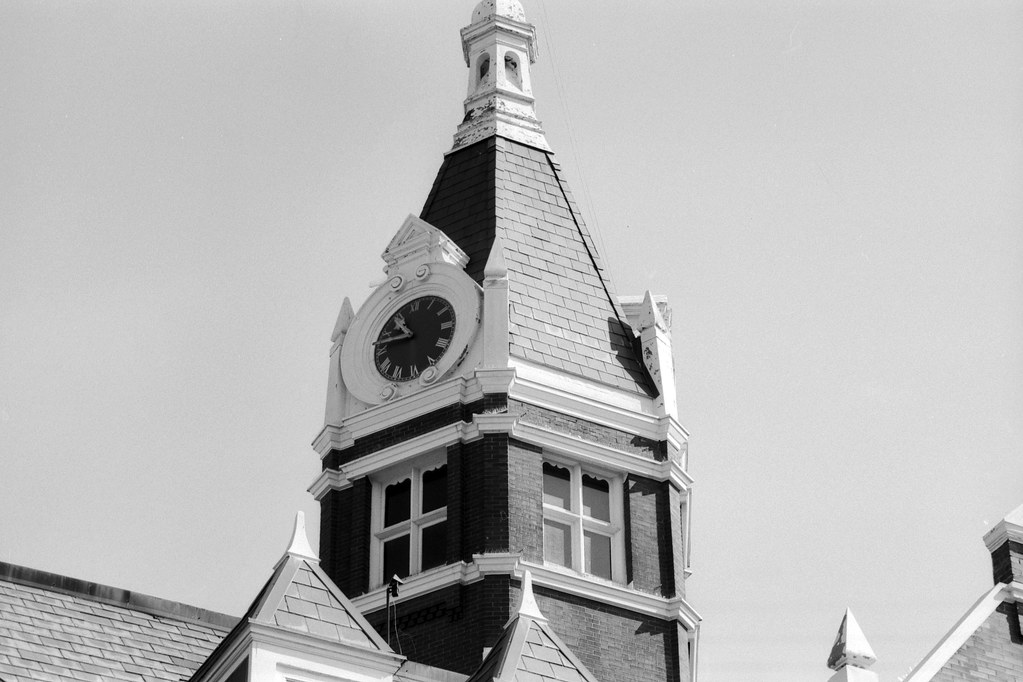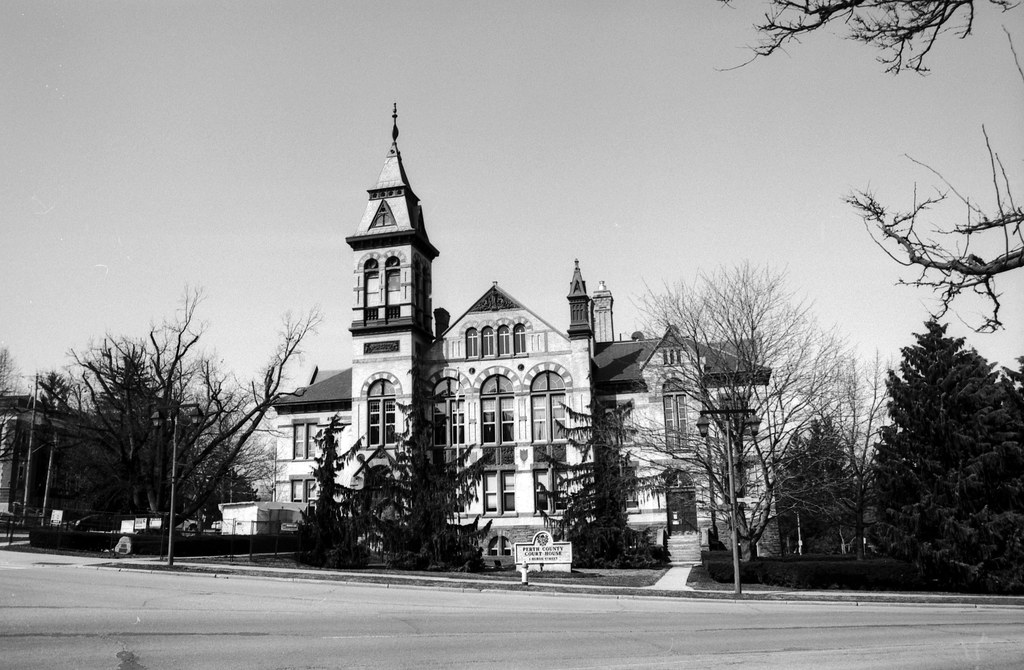If there is one city in Ontario that I always like to visit on projects, it is Stratford, Ontario. While far smaller than most cities in Ontario, Stratford offers a glimpse of what cities looked like in the 19th Century, with plenty of historic buildings scattered throughout. The city still holds onto some of its historical past with the railroad and furniture making. But also fully embraces its Shakespearian tourist present.

Konica-Minolta Maxxum 70 – Minolta Maxxum AF 28-100mm 1:3.5-5.6 D – Arista EDU.Ultra 100 @ ASA-100 – Foma Fomadon LQR (1+10) 6:00 @ 20C
The part of Ontario where Stratford is found was once home to the Attawondernk Civilisation; these indigenous peoples were lumped together under the Neutral name by the first French explorers and fur traders who arrived in what would become Ontario—named such as they refused to engage in active conflict with either the Wyandot or Haudenosaunee and preferred to trade with both. But like many indigenous peoples, the Attawondernk were destroyed during the Beaver Wars of the 1650s, and the area became part of the wider Haudenosaunee territory until the Anishinaabe forced them out. The Anishinaabe, better known to the colonists as the Mississaugas, were the ones who ceded the land to the British Crown under Treaty 29, the Huron Tract Purchase of 1827. The tract was turned over to the newly formed Canada Company to conduct the land surveys, construct roads and bridges, and supply needed equipment to ‘tame’ the land. The area along a small branch of the Thames River, known as the Little Thames, proved perfect for logging and farming. By 1828 the first small settlement grew up along the banks of the Thames. The tiny hamlet flew under the radar for the first few years, a small stop along the long Huron Road that ran from Guelph to Goderich. But Thomas Mercer Jones, the deputy governor of the Canada Company, saw the potential of a market town for the eastern part of the Huron Tract. In 1832, he arranged for a town site to be laid out and had a grist mill, sawmill, and the Hotel Shakespere built. He also renamed the Little Thames River to the Avon River. The hamlet also took Stratford, a name that stuck when the first post office opened in 1835. Growth was slow, and by 1846 the population was only 200 but had everything the urban centre of a farming community needed, the two mills, a brewery, distillery, ashery, blacksmiths, saddler, tanner, tailors, shoemakers, taverns, three stores, a doctor and a surgeon. When Perth County was formed in 1853, Stratford was named (by default) as the county seat, and three years later, two railways crossed paths within months of each other. The Grand Trunk Railway provided access back to Toronto, with an east-to-west route, and Buffalo & Lake Huron running south to north. By 1859 Stratford was incorporated as a town, and the railway became one of the biggest employers in town. The first large furniture makers established themselves in Stratford by the 1860s. The presence of the railway helped both the furniture industry and local farms, but that only got a boost when Grand Trunk took over Buffalo & Lake Huron. This merger put Stratford at a significant juncture, and Grand Trunk selected the town to be home to one of their major motive power shops and maintenance yards. In 1873 the new shops opened and put Grand Trunk on top as the primary economic driver for Stratford; it also propelled Stratford towards cityhood, incorporating as such in 1885. A grand new county court was completed in 1887, and a stunning city hall in 1898. The Stratford Teacher’s College opened in 1908, and a year later, Grand Trunk completed significant upgrades to the Motive Power Shops. The town received a pair of mute swans in 1918 (there are many more now). In 1933 a general strike crippled most of the furniture makers and some of the railway operations. The city called the Canadian Militia (Permanent Active Militia) to break the strike. Thankfully, there was only a little violence between the striking workers and their employers and authorities; it was also the last time the military was called in to break a strike. In 1953, the first Stratford Shakespeare Festival opened with several outdoor performances. The festival proved popular enough that in 1957 the Festival Theatre opened with great fanfare. The festival would take on an essential role in the continued economic stability of Stratford when in 1964, the Motive Power Shops were shut down as the last steam engines were taken out of service and diesel became the main motive power. Through the rest of the 20th Century, many historic buildings were preserved; the economic downturn and survival of the remaining furniture manufacturing and tourism prevented widespread urban renewal. Although the Stratford Festival quickly became the main economic driver for the city following the last furniture maker closed in 2006 and, despite the pandemic restrictions, reopened with great fanfare in 2023!

Konica-Minolta Maxxum 70 – Minolta Maxxum AF 28-100mm 1:3.5-5.6 D – Arista EDU.Ultra 100 @ ASA-100 – Foma Fomadon LQR (1+10) 6:00 @ 20C
Konica-Minolta Maxxum 70 – Minolta Maxxum AF 28-100mm 1:3.5-5.6 D – Arista EDU.Ultra 100 @ ASA-100 – Foma Fomadon LQR (1+10) 6:00 @ 20C
Konica-Minolta Maxxum 70 – Minolta Maxxum AF 28-100mm 1:3.5-5.6 D – Arista EDU.Ultra 100 @ ASA-100 – Foma Fomadon LQR (1+10) 6:00 @ 20C
Konica-Minolta Maxxum 70 – Minolta Maxxum AF 28-100mm 1:3.5-5.6 D – Arista EDU.Ultra 100 @ ASA-100 – Foma Fomadon LQR (1+10) 6:00 @ 20C
Having visited Stratford on many occasions, I came up with a bit of a hit list for those buildings I wanted to include in this entry. Most are directly connected to the history of the city. Of course, the main image for the set was that of the River Avon, although from an angle I had never used before. A taste of the historical buildings that go through the entire downtown, although not in much in the residential areas. But I did make a point to include many of the critical single buildings, the 1887 County Court (still used as the Perth County Court), the Walter Allward-designed Cenotaph (this was built before Allward’s iconic Vimy Memorial): the beautiful 1901 Armouries and 1908 Normal School. However, there are a few buildings that are glaringly missing from this post; these are because of lighting and location. The 1898 City Hall, because of the sun’s place when we were in the city and the 1957 Festival Theatre. These frames didn’t work because too much was lost in the shadows. The others because of their location. Even though Stratford is a tourist town, some parts aren’t as nice and not precisely visitor friendly, or at least folks with cameras. These include the former Motive Shops, the beautiful 1913 GTR station, and the former furniture shops. Although these parts of Stratford, I do want to explore these in more detail but on a dedicated Photowalk trip.

Konica-Minolta Maxxum 70 – Minolta Maxxum AF 28-100mm 1:3.5-5.6 D – Arista EDU.Ultra 100 @ ASA-100 – Foma Fomadon LQR (1+10) 6:00 @ 20C
Konica-Minolta Maxxum 70 – Minolta Maxxum AF 28-100mm 1:3.5-5.6 D – Arista EDU.Ultra 100 @ ASA-100 – Foma Fomadon LQR (1+10) 6:00 @ 20C
Konica-Minolta Maxxum 70 – Minolta Maxxum AF 28-100mm 1:3.5-5.6 D – Arista EDU.Ultra 100 @ ASA-100 – Foma Fomadon LQR (1+10) 6:00 @ 20C
Konica-Minolta Maxxum 70 – Minolta Maxxum AF 28-100mm 1:3.5-5.6 D – Arista EDU.Ultra 100 @ ASA-100 – Foma Fomadon LQR (1+10) 6:00 @ 20C
The day we visited Stratford was a bright sunny day; the sun was high when we were there. I’m a fan of shooting in hard light and see it as more of a challenge, but it quickly became harder than expected. The first is the sun’s position; as mentioned in the previous paragraph, it made some frames unusable as I lost all the shadow detail. The second choice of the developer is Foma Fomadon LQR. If you haven’t heard of LQR, that’s okay; it’s not widely known in North America, but it is Foma’s high-contrast liquid developer. Combine a high-contrast developer with high-contrast light, and you get a lot of contrast in your frames. There are a couple of things I probably should have done; the easiest would have been to set my meter to centre-weighted instead of averaging metering mode in a few cases, primarily to help get those shadow details. Another option would have been to over-expose by a stop, shoot the film at ASA-50, and then pull in development. I’m not sure that a yellow filter would have helped, maybe when combined with the one-stop over-exposure, but certainly not at full box speed.

Konica-Minolta Maxxum 70 – Minolta Maxxum AF 28-100mm 1:3.5-5.6 D – Arista EDU.Ultra 100 @ ASA-100 – Foma Fomadon LQR (1+10) 6:00 @ 20C
Konica-Minolta Maxxum 70 – Minolta Maxxum AF 28-100mm 1:3.5-5.6 D – Arista EDU.Ultra 100 @ ASA-100 – Foma Fomadon LQR (1+10) 6:00 @ 20C
Konica-Minolta Maxxum 70 – Minolta Maxxum AF 28-100mm 1:3.5-5.6 D – Arista EDU.Ultra 100 @ ASA-100 – Foma Fomadon LQR (1+10) 6:00 @ 20C
Konica-Minolta Maxxum 70 – Minolta Maxxum AF 28-100mm 1:3.5-5.6 D – Arista EDU.Ultra 100 @ ASA-100 – Foma Fomadon LQR (1+10) 6:00 @ 20C
If you live in Southern Ontario or are visiting, Stratford is well worth a visit. If you’re a fan of live theatre, then the Stratford Festival is undoubtedly worth a ticket. But that isn’t all; Stratford is well worth visiting for nature lovers, architecture, railway history, craft beer (there are two craft breweries), foodies, and photographers. In May, we’re finally heading into the big city of Toronto, Ontario. But not to focus on the city but rather dig into the history of distilling in colonial history and the rise of industry in Toronto.
1 Comment